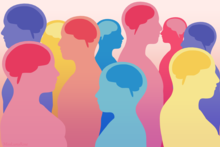Neurodiversity

Neurodiversity is a word for differences in people's brains. It is a type of biodiversity (diversity in living creatures).
Examples of neurodiverse conditions include autism, Tourette syndrome, ADHD, dyslexia and HSP.
Movement
[change | change source]The neurodiversity movement is an approach to mental disability in which some neurological conditions are variations of the human brain. The term was first used in the late 1990s as a challenge to the idea that neurological differences are disorders instead of features. The movement believes that these variations should be recognised as a social category along with gender, human race and sexual orientation.
Some people claim that neurodiversity would not be good for individuals with severe disabilities, such as low-functioning autism. They state that the difficulties are far greater than any potential strengths.[1]
Related pages
[change | change source]References
[change | change source]- ↑ Robison, John. "The Controversy Around Autism and Neurodiversity". Psychology Today. Retrieved 4 July 2020.

